Peace Propagation: Human Rights Day, Post Liberation 1994 South Africa (Part 1)
TRANSCEND MEMBERS, 25 Mar 2024
Prof Hoosen Vawda – TRANSCEND Media Service
Please note that this publication contains graphic images which may be disturbing to some readers. Reader discretion is advised. Parental guidance is recommended for minors who may use this publication as project or resource material.
***************************
“The 21st Century is hallmarked by repeated and serious violations of human rights, especially by the guardians of the so-called free spirit of democracy. This erosion of basic human rights is witnessed in freedom of speech and religious association. In these unfolding tragedies, South Africa stands proud by innovating the Human Rights Day as a public holiday and sustains it in protecting and ensuring that human rights are always respected.” [1]
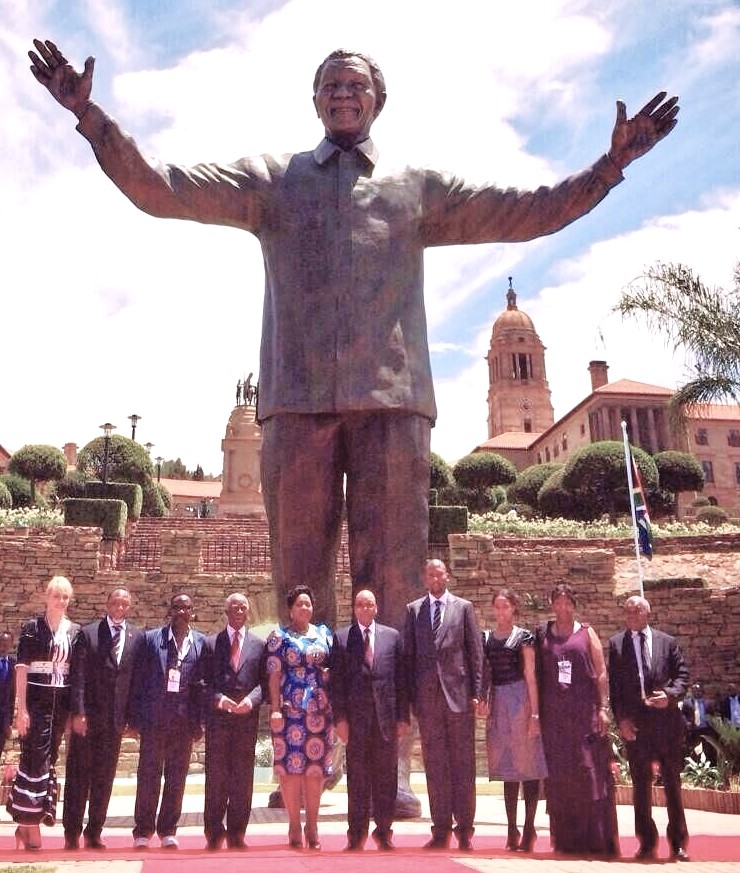
The Nelson Mandela statue, on the Union Buildings grounds, Pretoria, Gauteng, of former President of South Africa and anti-apartheid activist Nelson Mandela, stands 9 meters tall. The statue was unveiled on the Day of Reconciliation, 16 December 2013, bringing the official mourning period of ten days to a close, after Mandela died on 5 December.
The statue, at 9m high, is the tallest figurative statue of Nelson Mandela. It is made in bronze and weighs approximately 3.5 tons. From fingertip to fingertip, it measures 8 meters. The statue was cast in 147 pieces at four different foundries before being assembled in Cape Town, where the engineering work had been done by the Knight brothers at Sculpture Casting Services Foundry. The legs and arms were cast in Nottingham Road, KwaZulu-Natal. The statue was inaugurated by then President of South Africa Jacob Zuma, who in his speech said:
You will notice that in all the statues that have been made of Madiba, he is raising his fist and at times stretching it. That derives from the slogan of the ANC. This one is different from many. He is stretching out his hands. He is embracing the whole nation. You shouldn’t say this is not Madiba because we know him with his one [raised] hand. The statue is located in front of the buildings on a spot that used to belong to the statue of J.B.M. Hertzog who was the Prime Minister of South Africa from 1924-1939. Hertzog’s statue was taken down on 22 November 2013 and moved to a different location in the grounds. In January 2014 it was discovered that there was a tiny rabbit in the statue’s right ear. According to the artists, Andre Prinsloo and Ruhan Janse van Vuuren, they added the bunny in lieu of signing the sculpture, and in remembrance of how quickly they had to produce it. (The Afrikaans word “haas” means both rabbit and “quickly” in English.) After a furore, the artists apologised and the Department of Arts and Culture had the offending bunny removed.
Photo Credit: www.bing.com
The Origins and Rationale for the Human Rights Day.
The Human Rights Day is a South African public holiday commemorated annually on the 21st March. It serves as a poignant reminder to South Africans and indeed the rest of the world, about the sacrifices made during the struggle for democracy in the country. In the 1960s, systematic defiance and protest against apartheid and racism were widespread. On 21st March 1960, the community of Sharpeville and Langa townships embarked on a protest march against pass laws. Tragically, the apartheid police shot and killed 69 protesters at Sharpeville, many of whom were shot while fleeing. This event, known as the Sharpeville Massacre[11], exposed the apartheid government’s deliberate violation of human rights to the world. In honour of those who fought for liberation and the rights we enjoy today, the democratic government declared 21st March as the Human Rights Day. The author has published extensively on the martyrs[12],[13],[14],[15],[16],[17],[18],[19],[20],[21],[22],[23] of apartheid,[24] previously to highlight the greatest sacrifice made in the liberation struggle and white domination. These brave men and women of the anti-apartheid struggle, paid dearly with their lives, which were terminated by the agents of the apartheid government, in extrajudicial killings,[25],[26],[27] as it is presently happening in Palestine, with ongoing genocidal atrocities committed by Israel, with impunity and absolutely no accountability. South Africans commemorate this day to reinforce their commitment to the Bill of Rights, enshrined in South African Constitution[28], which includes principles such as equality, human dignity, freedom of movement, language, culture, and the right to life.
Human Rights Day in South Africa holds a significant place in the local history. It is relevant to review its origins and rationale:
Sharpeville Massacre:
- On March 21, 1960, a pivotal moment occurred in South Africa’s history. In the township of Sharpeville, police opened fire on peaceful protesters who were demonstrating against apartheid’s discriminatory policies.
- Tragically, 69 people lost their lives, and hundreds were injured in what became known as the Sharpeville Massacre.
- This event marked a turning point in the struggle against apartheid and garnered international condemnation of South Africa’s racial segregation policies.
Proclamation of Human Rights Day:
- In the aftermath of the Sharpeville Massacre, the United Nations General Assembly declared March 21st as the International Day for the Elimination of Racial Discrimination.[29]
- In South Africa, this day evolved into Human Rights Day, a national public holiday.
- It serves as a commemoration of the sacrifices made by those who fought against apartheid and advocates for the protection of human rights for all citizens.
Legacy of Nelson Mandela:
- Nelson Mandela, a central figure in the fight against apartheid, left an indelible mark on Human Rights Day.
- His unwavering commitment to human rights and reconciliation continues to inspire people globally.
- Human Rights Day stands as a poignant reminder of his enduring influence.
Importance of Human Rights Day:
Promoting Equality and Justice:
- Human Rights Day provides a platform to promote equality, justice, and dignity for all individuals, regardless of race, gender, or background.
- It reminds us of the importance of upholding fundamental human rights and working towards a society where everyone is treated with respect and fairness.
Commemorating Sacrifice and Struggle:
- This day honours the sacrifices and struggles of those who fought against apartheid and oppression in South Africa.
- It allows us to remember the bravery of activists, leaders, and ordinary citizens who stood up for their rights and contributed to dismantling apartheid.
Advocating Change:
- Human Rights Day encourages ongoing advocacy and activism to address contemporary human rights challenges.
- It serves as a call to action to confront issues such as discrimination, inequality, and social injustice, working toward a more inclusive and equitable society.
Celebrating Diversity and Inclusion:
- Human Rights Day celebrates the diversity of South Africa’s people and promotes inclusion and acceptance of all communities.
In summary, Human Rights Day serves as a powerful reminder of our shared responsibility to uphold and protect the rights of every individual.
Human Rights Day, while specifically associated with South Africa, has counterparts and similar observances in other parts of the world. These events highlight the importance of human rights, justice, and equality. Here are a few examples:
International Human Rights Day:
- December 10th is recognised globally as International Human Rights Day[30]. It commemorates the adoption of the Universal Declaration of Human Rights by the United Nations General Assembly in 1948.
- On this day, people around the world advocate for human rights, raise awareness about violations, and promote the principles of dignity, freedom, and equality.
Anti-Racism Day:
- Some countries observe Anti-Racism Day or International Day for the Elimination of Racial Discrimination on March 21st[31], aligning with South Africa’s Human Rights Day.
- This day emphasizes the fight against racism, discrimination, and prejudice, echoing the spirit of solidarity seen during the struggle against apartheid.
Freedom Day (South Africa):[32]
- While not directly equivalent, Freedom Day in South Africa, celebrated on April 27th, also relates to human rights.
- It marks the first democratic elections held in 1994, ending apartheid and granting all citizens the right to vote and participate in shaping the nation’s future.
Other National Observances:
- Various countries have their own national days dedicated to human rights, civil liberties, and social justice.
- These may not always align with South Africa’s Human Rights Day but share the common goal of promoting and protecting fundamental rights.
Remember that the fight for human rights is universal, and these observances serve as reminders to uphold the dignity and well-being of all individuals, regardless of their background or circumstances.
The Civil Rights Movement in the United States [33]was a pivotal struggle for social justice that spanned mainly from the 1950s to the 1960s. Its primary goal was to secure equal rights for Black Americans under the law. Let’s explore its origins, key events, and significance:
Roots of the Civil Rights Movement:
- The movement’s roots trace back to centuries of efforts by enslaved Africans and their descendants to abolish slavery and resist racial oppression.
- Despite the abolition of slavery after the Civil War[34], discrimination against Black people persisted, especially in the South.
Jim Crow Laws and Segregation[35]:
- In the late 19th century, the Jim Crow laws were established in the South. These laws enforced racial segregation, preventing Black people from using the same facilities as white people.
- Black Americans faced discrimination in jobs, housing, education, and voting rights. Even in northern states, they encountered prejudice.
World War II and Executive Order 8802:[36]
- During World War II, Black Americans worked in low-wage jobs and faced segregation and discrimination.
- In response to demands for equal employment rights, President Franklin D. Roosevelt [37]issued Executive Order 8802 in 1941, opening national defence jobs to all Americans, regardless of race.
- Black men and women served heroically in the war, despite the challenges they faced.
Civil Rights Movement Milestones:[38]
- Brown v. Board of Education (1954)[39]: The Supreme Court ruled that racial segregation in public schools was unconstitutional.
- Montgomery Bus Boycott [40](1955-1956): Rosa Parks’s refusal to give up her bus seat sparked a year-long boycott, leading to desegregation of buses.
- March on Washington [41](1963): Dr. Martin Luther King Jr. delivered his iconic “I Have a Dream” [42]speech, advocating for equality and justice.
- Civil Rights Act of 1964[43]: Banned discrimination based on race, colour, religion, sex, or national origin.
- Voting Rights Act of 1965[44]: Aimed to eliminate barriers to voting for Black Americans.
Legacy and Ongoing Struggle:
- The Civil Rights Movement achieved significant victories, but the struggle for equality continues.
- It inspired future movements for women’s rights, LGBTQ+ rights, and disability rights.
Civil Rights Movement Day is not an official holiday, but Martin Luther King Jr. Day [45](observed on the third Monday of January) honours Dr. King’s contributions to the movement. It serves as a reminder of the ongoing fight for justice and equality
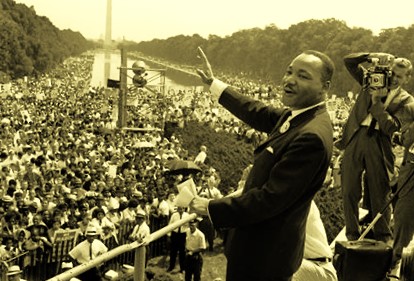
Martin Luther King Jr. zdraví účastníky pochodu na Washington.
It was a speech that the world cannot forget. On August 28, 1963, an estimated 250,000 people marched to the Lincoln Memorial in Washington where they heard Martin Luther King Jr. give a speech destined to resonate through the ages.
In what became known as the “I Have a Dream” speech, King gave impassioned voice to the demands of the U.S. Civil Rights Movement — equal rights for all citizens, regardless of the color of their skin.
Some historians maintain that King’s speech, delivered at one of the largest civil rights demonstrations in U.S. history, was one of those rare moments that changed a nation — paving the way for a transformation of American law and life.
“It was a very peaceful day. A sea of white as well as black faces enveloped the Mall,” the late Dorothy Height, president emeritus of the National Council of Negro Women (NCNW), wrote in 2005. Height, one of the march’s organizers, sat behind King on the platform. “I think it was a decisive moment not only in U.S. civil rights history, but also in American history. It resulted in a new determination to move toward equality, freedom and greater employment for people of color.”
According to Height, “The real significance of the march, and the speech, was that it changed attitudes. Righteous indignation against racial discrimination became widespread after the march. It led to a time so full of promise and achievement. You could feel it.”
Less than a year after the march, President Lyndon Johnson signed into law the 1964 Civil Rights Act, which banned discrimination in public facilities, such as hotels and restaurants, and also prohibited employment discrimination. The following year, passage of the Voting Rights Act ensured African Americans could freely exercise their franchise.
South Africa holds the distinction of being one of the first countries to officially observe Human Rights Day as a public holiday. This significant day commemorates the struggle against apartheid, the sacrifices made by activists, and the ongoing pursuit of justice and equality for all. South Africa has certainly changed since the end of apartheid and has undergone significant transformations across various aspects of society. Here are ten key changes that have occurred:
New Constitution and Flag:[46]
- After apartheid, South Africa adopted a new constitution in 1993, providing the framework for reversing apartheid laws.
- The new flag symbolized unity and inclusivity.
Land Ownership Reform[47]:
- Nelson Mandela’s African National Congress aimed to reverse unequal land ownership laws.
- Policies changed to allow non-white South Africans to own land, addressing historical injustices.
Freedom of Movement:
- The oppressive “pass laws” restricting non-white movement were abolished.
- South Africans gained the freedom to move without passes and access previously restricted areas.
Democracy and Elections:
- In 1994, South Africa held its first democratic all-races-included general election.
- Nelson Mandela became the first black president, marking a historic shift.
Reconciliation and Truth Commission[48]:
- The Truth and Reconciliation Commission addressed human rights abuses during apartheid.
- It promoted healing, forgiveness, and understanding.
Education and Equality:
- Efforts were made to improve education for all, bridging historical disparities.
- Equal access to quality education became a priority.
Economic Empowerment:
- Black economic empowerment initiatives aimed to uplift previously disadvantaged communities.
- Policies encouraged black ownership and participation in the economy.
Cultural Diversity and Identity:
- South Africans celebrated their diverse cultural heritage.
- Indigenous languages gained recognition and respect.
Healthcare and Social Services:
- Access to healthcare and social services improved for marginalized communities.
- Efforts were made to address health disparities.
International Recognition and Unity:
- South Africa gained global recognition for its transition from apartheid to democracy.
- The nation worked toward unity, healing, and reconciliation.
Despite progress, challenges remain. Some apartheid victims seek justice, and ongoing efforts are needed to address inequality and historical legacies. South Africa continues its journey toward a more just and equitable society.
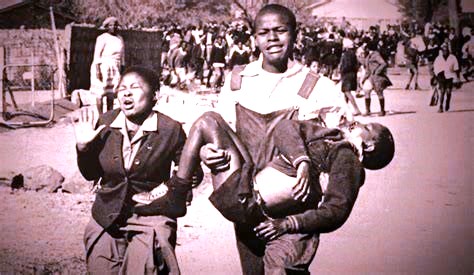
The iconic and fateful picture that captures the oppression of the minority, White Apartheid brutality against the majority, indigenous Black People, during the Sharpeville Massacre in South Africa, during the darkest period of the discriminatory regime.
The Ongoing Police Brutality in the United States against people of Colour in the 21st century[49]
The struggle against racial injustice and police brutality is not unique to South Africa; it has also deeply affected the United States. Here are some notable cases of brutality against Black people in the U.S.:
Eric Garner (July 2014):[50]
- Eric Garner died after being wrestled to the ground by a New York police officer on suspicion of illegally selling cigarettes.
- While in a chokehold, Garner repeatedly said, “I can’t breathe.” His death led to widespread protests and calls for justice.
- The police officer involved was fired but never prosecuted.
Michael Brown (August 2014):[51]
- Michael Brown, an 18-year-old, was killed by a police officer in Ferguson, Missouri.
- The officer, Darren Wilson, shot Brown during an altercation. The incident sparked violent protests and civil unrest.
- Although the officer was cleared of wrongdoing, a Department of Justice report highlighted systemic problems in the Ferguson police force.
Tamir Rice (November 2014):[52]
- Tamir Rice, a 12-year-old boy, was shot dead in Cleveland, Ohio, by a police officer.
- The police responded to reports of a male pointing a toy gun at passers-by. Rice was shot seconds after their arrival.
- The officer who fired the fatal shots was later fired for lying on his job application, but no federal charges were filed.
Walter Scott (April 2015):[53]
- Walter Scott was shot in the back five times by a white police officer in North Charleston, South Carolina.
- Scott had been pulled over for a defective car light. The officer was eventually sentenced to 20 years in prison.
George Floyd (May 2020):[54]
- George Floyd’s death in Minneapolis, Minnesota, ignited global outrage.
- A police officer knelt on Floyd’s neck for over nine minutes, despite his pleas that he couldn’t breathe.
- Floyd’s death led to massive protests, renewed calls for police reform, and a focus on systemic racism.
Ongoing Patterns:
- Despite increased awareness and activism, data from 2021 show that Black people are still disproportionately killed by police.
- Black people, who make up 13% of the U.S. population, accounted for 27% of those fatally shot by police officers[55].
These cases highlight the urgent need for systemic change, accountability, and justice. The fight against racial injustice continues, both in the U.S. and globally.
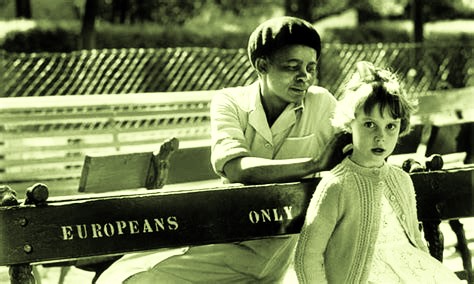
The comprehensive discrimination policy of Apartheid in Pre-1994 South Africa, with violation of basic Human Rights. Note that the African lady could be employed to care for children, as domestic helpers by white families, but they could not use the seating facilities, in a public place reserved, by legislature for the exclusive use by Europeans, only, with no similar rest facilities for people of Colour.
Photo Credit: Celebrated photographer Peter Magubane documented pivotal moments, exposing the harsh realities faced by Black communities, during the apartheid regime, in South Africa.
The Spectre of Systemic Racism, Globally[56]
Systemic racism is a pervasive and deeply ingrained phenomenon that systematically puts Black people, Indigenous people, and other people of colour at compounded disadvantage within a society. It operates across various domains, including institutions, policies, and individual interactions. A definition and some major historical cases are pertinent:
Definition of Systemic Racism:
- Systemic racism occurs when racially unequal opportunities and outcomes are inbuilt or intrinsic to the operation of a society’s structures.
- It refers to the processes and outcomes of racial inequality and inequity in life opportunities, treatment, and access to resources.
- Systemic racism can operate with or without intention and with or without awareness but has profound effects on marginalized communities.
Major Cases of Systemic Racism:
Slavery (17th to 19th Century):[57]
- The transatlantic slave trade forcibly brought millions of Africans to the Americas as slaves.
- Slavery was a deeply entrenched system of racial oppression, with Black people subjected to brutal conditions, violence, and dehumanisation.
Jim Crow Laws (Late 19th to Mid-20th Century):[58]
- After the abolition of slavery, the Jim Crow laws enforced racial segregation in the Southern United States.
- Black Americans faced discrimination in education, transportation, housing, and voting rights.
Redlining (20th Century):[59]
- Redlining was a discriminatory practice by which banks and government agencies denied loans and services to Black neighbourhoods.
- This led to racial segregation, limited economic opportunities, and disinvestment in Black communities.
Mass Incarceration (20th Century to Present):
- The War on Drugs disproportionately targeted Black communities, resulting in high incarceration rates.
- Mandatory minimum sentences and biased policing contributed to systemic racism within the criminal justice system.
Educational Disparities (20th Century to Present):
- Unequal funding, resource allocation, and discriminatory policies have perpetuated educational disparities.
- Black students often attend underfunded schools with fewer opportunities.
Healthcare Inequities (20th Century to Present):
- Black Americans face disparities in healthcare access, quality, and outcomes.
- Historical mistreatment, bias, and socioeconomic factors contribute to systemic health inequities.
Housing Discrimination (20th Century to Present):
- Racially segregated housing policies persist, limiting Black Americans’ access to safe neighbourhoods and homeownership.
- Redlining’s legacy continues to shape housing opportunities.
Police Brutality and Racial Profiling (20th Century to Present):
- Incidents like the Rodney King beating, Eric Garner’s death, and the killing of George Floyd highlight systemic racism within law enforcement.
- Racial profiling and excessive use of force disproportionately affect Black communities.
Voter Suppression (20th Century to Present):
- Historical and contemporary efforts to disenfranchise Black voters persist.
- Voter ID laws, gerrymandering, and limited polling locations disproportionately affect Black voters.
Economic Disparities (20th Century to Present):
- Black Americans face wage gaps, limited access to capital, and barriers to economic mobility.
- Systemic racism perpetuates economic inequality.
Environmental Racism (20th Century to Present):[60]
- Toxic waste sites, pollution, and lack of environmental protections disproportionately affect Black neighbourhoods.
- Environmental justice remains a critical issue.
These cases illustrate how systemic racism has shaped the lives of Black people over centuries, impacting their opportunities, health, education, and overall well-being. Acknowledging and dismantling these systems is essential for achieving true equality and justice.
Activism against systemic racism[61]
To actively combat systemic racism, there are several impactful steps that can be taken:
Education on Racism and its subtleties:
- Learn about the unique ways systemic racism affects various groups.
- Understand the historical context, current challenges, and ongoing efforts to dismantle racist systems.
Support Organizations:
- Donate to organizations that fight against racism and promote racial equity.
- Volunteer your time or skills to support their initiatives.
Advocate for Change:
- Push for policy reforms at local, national, and international levels.
- Advocate for equitable laws, criminal justice reform, and anti-discrimination policies.
Build Solidarity:
- Stand in solidarity with marginalized communities.
- Attend rallies, protests, and community events to show your support.
Engage in Conversations:
- Talk openly about systemic racism with friends, family, and colleagues.
- Encourage dialogue and challenge misconceptions.
Remember, as civil rights leader Fannie Lou Hamer [62]said, “Nobody’s free until everybody’s free.” Active participation matters in the fight against systemic racism.
The Bottom Line in Erosion of Human Rights[63],[64]
To examine and appreciate the essence of Human Rights and its impact on sectors of marginalized citizenry, by overt or covert government discrimination as it was legislated in the pre-liberation 1994, in South Africa and presently in Palestine, by Zionist occupying forces, which no country apart from South Africa has raised the matter officially in the International Court of Justice on 29th December 2023, much to the dismay of the United States as well as some European countries. In fact United States, under the Biden Administration is complicit in the genocide of Palestinians and crimes against humanity, by aiding and supporting the Zionist state of Israel., in its War On Gaza. leading to the ruthless annihilation of over 32,000 Palestinians since the 07th October 2023.[65]
It is necessary to enquire as to what are the differences between Systemic Racism, Apartheid, Ethnophobia, Xenophobia. as well as how are these human discriminatory patterns, interrelated over the different historical eras:
Systemic Racism:[66]
Definition: Systemic racism refers to the institutionalized and structural discrimination against racial or ethnic groups.
Characteristics:
- It operates within systems, institutions, and policies.
- It perpetuates racial disparities in areas such as education, employment, housing, and criminal justice.
- Systemic racism is often unintentional but deeply ingrained.
Examples:
- Redlining in the U.S., where discriminatory housing policies disproportionately affected Black communities.
- Unequal access to quality education and healthcare based on race.
Apartheid:[67]
Definition: Apartheid was a legal system of racial segregation and discrimination enforced in South Africa from 1948 to 1994.
Characteristics:
- It was government-sanctioned and systematic.
- It divided people based on race, restricting their rights and movement.
- Apartheid laws enforced racial separation in all aspects of life.
Examples:
- Separate schools, hospitals, and neighborhoods for different racial groups.
- Pass laws that restricted Black people’s movement.
Ethnophobia:[68]
Definition: Ethnophobia is the fear or hatred of people from different ethnic backgrounds.
Characteristics:
- It focuses on ethnic identity rather than race.
- It can lead to discrimination, exclusion, or violence against specific ethnic groups.
Examples:
- Ethnic conflicts in regions like the Balkans or Rwanda.
- Discrimination against minority ethnic groups in various countries.
Xenophobia:[69]
Definition: Xenophobia is the fear and hatred of strangers or foreigners.
Characteristics:
- It targets people based on their foreign origin.
- It often arises from economic, political, or social tensions.
Examples:
- Anti-immigrant sentiments during economic downturns.
- Violence against refugees or migrants.
Interrelated Aspects:
- Colonial Legacy: Apartheid in South Africa was rooted in colonial history, where racial hierarchies were established.
- Global Context: Systemic racism, ethnophobia, and xenophobia are global issues influenced by historical events and power dynamics.
- Overlapping Effects: Discriminatory patterns often intersect. For example, apartheid laws were both racist and xenophobic.
- Shared Struggles: Movements against apartheid, systemic racism, and xenophobia share common goals of justice, equality, and human rights.
In summary, these discriminatory patterns have evolved over different eras, but they remain interconnected in their impact on marginalized communities. Recognizing and addressing them is crucial for creating a more equitable world.
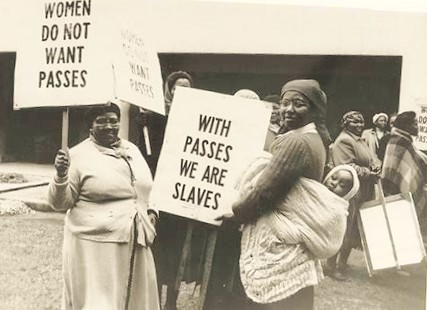
The 1956, Women’s Anti-Apartheid March in Pretoria, South Africa.
Women played a crucial role in the struggle against the oppressive apartheid regime in South Africa. The 1956 march in Pretoria was a powerful demonstration against apartheid laws. A similar situation prevails in Israel against the Palestinians in the 21st century.
Photo Credit: Peter Magubane, a prominent Black Apartheid Photographer
References:
[1] Personal quote by author, March 2024
[2] https://www.gov.za/HumanRightsMonth2024
[3] https://housing.com/haripura-surat-overview-P5eenbfzc9okmtthg
[4] https://www.sahistory.org.za/place/grey-street-durban-city-centre
[5] Family owned, professional photographic studio in the 1950’s. A Kamera Kraft exists today in Lahore, as well. https://www.google.com/maps/place/Kamera+Kraft+Studio/@31.5353724,74.3934968,17z/data=!3m1!4b1!4m6!3m5!1s0x3919057aab9a6e55:0x98142214c04cb622!8m2!3d31.5353724!4d74.3934968!16s%2Fg%2F11gdknjzty?entry=ttu
[6] https://www.google.com/search?q=Leica+Camera+111G+in+1955&sca_esv=da8686212ff90448&rlz=1C1CHBD_enZA1102ZA1102&ei=RHf_Ze26LaLbi-gPm_a3mA8&ved=0ahUKEwjt7JLN1YuFAxWi7QIHHRv7DfMQ4dUDCBA&oq=Leica+Camera+111G+in+1955&gs_lp=Egxnd3Mtd2l6LXNlcnAiGUxlaWNhIENhbWVyYSAxMTFHIGluIDE5NTUyBRAhGKABMgUQIRigATIFECEYoAEyBRAhGKABSPZEUM4jWM4jcAJ4AZABAJgB2gKgAdoCqgEDMy0xuAEMyAEA-AEB-AECmAIDoAKGA6gCFMICHRAAGIAEGIoFGOUCGOUCGOoCGLQCGIoDGLcD2AEBwgIWEAAYAxiPARjlAhjqAhi0AhiMA9gBAsICFhAuGAMYjwEY5QIY6gIYtAIYjAPYAQKYAxW6BgQIARgHugYGCAIQARgKkgcFMi4zLTGgB7kD&sclient=gws-wiz-serp
[7] https://journals.co.za/doi/pdf/10.10520/AJA20785135_41463
[8] https://www.sahistory.org.za/article/freedom-day-27-april
[9] https://en.wikipedia.org/wiki/Nelson_Mandela
[10] https://www.traveldiariesapp.com/en/diary/5a803b81-3631-498d-9136-5e95d7c15997/chapter/7fe7dc47-b129-4c50-b065-c013812bad17
[11] https://en.wikipedia.org/wiki/Sharpeville_massacre
[12] https://www.transcend.org/tms/2024/01/a-holistic-analysis-of-apartheid-and-related-ideologies-as-a-universal-peace-disruptor/
[13] https://www.transcend.org/tms/2023/09/heavenly-peace-of-the-oppressor-and-hellish-peace-of-the-oppressed/
[14] https://www.transcend.org/tms/2023/08/palestinophobia-and-africanophobia-apartheid-parallels-in-contemporary-history/
[15] https://www.transcend.org/tms/2023/08/the-resurrection-of-the-luciferous-demons-of-democracy-and-archangels-of-autocracy-as-peace-disruptors-in-south-africa-part-2/
[16] https://www.transcend.org/tms/2022/08/the-circle-of-peace-and-tranquility-the-karamat-of-the-sultan-shaykh-sheikh-abdurahman-matebe-shah-part-3/
[17] https://www.transcend.org/tms/2022/08/the-circle-of-peace-and-tranquility-the-karamat-of-abadin-tadia-tjoessoep-part-2/
[18] https://www.transcend.org/tms/2022/08/the-circle-of-peace-and-tranquility-the-karamat-of-sheik-sayed-abduraghman-motura-part-1/
[19] https://www.transcend.org/tms/2022/08/the-martyrs-of-apartheid-in-pre-1994-south-africa-imam-abdullah-haron-cape-town-part-4/
[20] https://www.transcend.org/tms/2022/07/the-martyrs-of-apartheid-in-pre-1994-south-africa-steve-biko-part-3/
[21] https://www.transcend.org/tms/2022/07/the-martyrs-of-apartheid-in-pre-1994-south-africa-dr-neil-hudson-aggett-part-2/
[22] https://www.transcend.org/tms/2022/07/the-martyrs-of-apartheid-in-pre-1994-south-africa-ahmed-timol-part-1/
[23] https://www.transcend.org/tms/2022/03/mohandas-karamchand-gandhi-the-making-of-the-mahatma-in-south-africa/
[24] https://www.transcend.org/tms/2021/05/in-the-shadow-and-shade-of-apartheid-in-south-africa-post-liberation-impact-on-the-rainbow-nation/
[25] https://www.transcend.org/tms/2022/12/the-forgotten-journalists-part-1-the-assassination-of-shireen-abu-akleh/
[26] https://www.transcend.org/tms/2022/05/the-global-killing-fields-of-journalists-the-death-of-shireen-abu-akleh-part-1/
[27] https://www.transcend.org/tms/2022/05/the-global-killing-fields-of-journalists-the-silence-of-the-world-part-2/
[28] https://paralegaladvice.org.za/wp-content/uploads/2016/05/01-PLM2015-Constitution.pdf
[29] https://www.un.org/en/observances/end-racism-day
[30] https://www.un.org/en/observances/human-rights-day
[31] https://www.ohchr.org/en/statements-and-speeches/2024/03/international-day-elimination-racial-discrimination-turk-calls#:~:text=To%20end%20the%20humiliation.,voice%20and%20fight%20for%20change.
[32] https://en.wikipedia.org/wiki/Freedom_Day_(South_Africa)
[33] https://www.khanacademy.org/humanities/us-history/postwarera/civil-rights-movement/a/introduction-to-the-civil-rights-movement#:~:text=Overview,period%20from%201946%20to%201968.
[34] https://education.nationalgeographic.org/resource/slavery-abolished#:~:text=On%20December%2018%2C%201865%2C%20the,people%2C%20from%20Kentucky%20to%20Delaware.
[35] https://en.wikipedia.org/wiki/Jim_Crow_laws#:~:text=Such%20continuing%20racial%20segregation%20was,others%2C%20beginning%20in%20the%201870s.
[36] https://www.archives.gov/milestone-documents/executive-order-8802#:~:text=In%20June%20of%201941%2C%20President,engaged%20in%20war%2Drelated%20work.
[37] https://www.whitehouse.gov/about-the-white-house/presidents/franklin-d-roosevelt/
[38] https://www.pbs.org/wgbh/americanexperience/features/eyesontheprize-milestones-civil-rights-movement/
[39] https://www.archives.gov/milestone-documents/brown-v-board-of-education#:~:text=On%20May%2017%2C%201954%2C%20U.S.,amendment%20and%20was%20therefore%20unconstitutional.
[40] https://kinginstitute.stanford.edu/montgomery-bus-boycott
[41] https://www.britannica.com/event/March-on-Washington#:~:text=March%20on%20Washington%2C%20political%20demonstration,that%20was%20pending%20in%20Congress.
[42] https://www.americanrhetoric.com/speeches/mlkihaveadream.htm
[43] https://www.dol.gov/agencies/oasam/civil-rights-center/statutes/civil-rights-act-of-1964#:~:text=In%201964%2C%20Congress%20passed%20Public,hiring%2C%20promoting%2C%20and%20firing.
[44] https://en.wikipedia.org/wiki/Voting_Rights_Act_of_1965#:~:text=The%20Voting%20Rights%20Act%20of,law%20by%20President%20Lyndon%20B.
[45] https://www.parents.com/holiday/martin-luther-king-jr-day-primer/#:~:text=by%20Karen%20Cilli-,Martin%20Luther%20King%20Jr.,holiday%20devoted%20to%20one%20man.
[46] https://www.apartheidmuseum.org/exhibitions/the-new-constitution
[47] https://www.gov.za/issues/land-reform
[48] https://en.wikipedia.org/wiki/Truth_and_Reconciliation_Commission_(South_Africa)
[49] https://www.ncbi.nlm.nih.gov/pmc/articles/PMC7331505/#:~:text=In%202018%2C%20there%20were%20996,population%20as%20of%20June%202020.%E2%80%9D
[50] https://en.wikipedia.org/wiki/Killing_of_Eric_Garner#:~:text=On%20July%2017%2C%202014%2C%20Eric,prohibited%20chokehold%20while%20arresting%20him.
[51] https://en.wikipedia.org/wiki/Killing_of_Michael_Brown
[52] https://www.chandralaw.com/files/blog/Rice-Wobrock-Preliminary-Repor.pdf
[53] https://en.wikipedia.org/wiki/Killing_of_Walter_Scott
[54] https://www.cnn.com/2020/05/29/us/minneapolis-george-floyd-friday/index.html
[55] https://www.ncbi.nlm.nih.gov/pmc/articles/PMC6080222/
[56] https://press.princeton.edu/books/hardcover/9780691177137/the-spectre-of-race
[57] https://www.nationalarchives.gov.uk/education/resources/slavery/#:~:text=As%20European%20settlement%20grew%2C%20so,the%20mid%2D17th%20century%20onwards.
[58] https://www.history.com/topics/early-20th-century-us/jim-crow-laws
[59] https://www.federalreservehistory.org/essays/redlining#:~:text=The%20FHA%20began%20redlining%20at,20%2Dyear%20loans%20they%20were
[60] https://en.wikipedia.org/wiki/Environmental_racism#:~:text=edit%5D-,Environmental%20racism%20is%20a%20form%20of%20institutional%20racism%2C%20which%20has,and%20oil%20or%20gas%20extraction.
[61] https://scholar.google.co.za/scholar?q=Activism+against+systemic+racism&hl=en&as_sdt=0&as_vis=1&oi=scholart
[62] https://www.womenshistory.org/education-resources/biographies/fannie-lou-hamer
[63] https://www.hrw.org/news/2017/03/08/erosion-human-rights-protection-systems
[64] https://www.transcend.org/tms/2021/06/endogenous-racism-against-people-of-african-origins-tulsa-and-sharpeville-parallels-in-history-part-2/
[65] https://www.transcend.org/tms/2023/05/peace-disruption-part-1-palestines-killing-fields-ignominious-beginnings/
[66] https://dictionary.cambridge.org/dictionary/english/systemic-racism
[67] https://en.wikipedia.org/wiki/Apartheid
[68] https://www.jstor.org/stable/20011154
[69] https://www.dictionary.com/browse/xenophobia
_____________________________________________
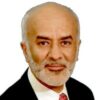 Professor G. Hoosen M. Vawda (Bsc; MBChB; PhD.Wits) is a member of the TRANSCEND Network for Peace Development Environment.
Professor G. Hoosen M. Vawda (Bsc; MBChB; PhD.Wits) is a member of the TRANSCEND Network for Peace Development Environment.
Director: Glastonbury Medical Research Centre; Community Health and Indigent Programme Services; Body Donor Foundation SA.
Principal Investigator: Multinational Clinical Trials
Consultant: Medical and General Research Ethics; Internal Medicine and Clinical Psychiatry:UKZN, Nelson R. Mandela School of Medicine
Executive Member: Inter Religious Council KZN SA
Public Liaison: Medical Misadventures
Activism: Justice for All
Email: vawda@ukzn.ac.za
Tags: Africa, Human Rights, Nelson Mandela, Peace, South Africa
This article originally appeared on Transcend Media Service (TMS) on 25 Mar 2024.
Anticopyright: Editorials and articles originated on TMS may be freely reprinted, disseminated, translated and used as background material, provided an acknowledgement and link to the source, TMS: Peace Propagation: Human Rights Day, Post Liberation 1994 South Africa (Part 1), is included. Thank you.
If you enjoyed this article, please donate to TMS to join the growing list of TMS Supporters.

This work is licensed under a CC BY-NC 4.0 License.